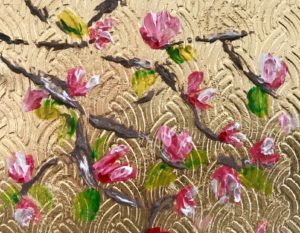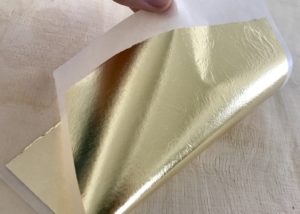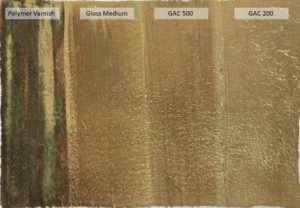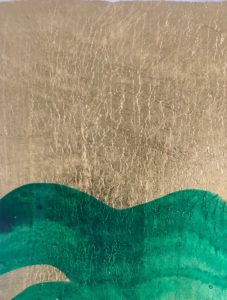
Gold leaf can be a wonderful addition to acrylic paintings, as it provides contrast in sheen and reflectance. We are often asked if it is possible to paint on top of gold leaf with acrylic paints and whether it is necessary to seal the gold leaf before doing so. The short answer is: intermediate coatings are required on most imitation leafs, before painting with acrylics, in order to reduce tarnishing. Since ammonia, which is found in all waterborne acrylic paints and mediums accelerates tarnishing of copper-based imitation gold leaf, we recommend our MSA Varnish or Archival Varnish w/UVLS as a protective coating, before painting over imitation leaf with acrylic paints.
Genuine Gold and Imitations
Genuine 24k gold consists only of the precious metal gold and does not tarnish. Thus it can be painted over with acrylics directly. Fewer karats of genuine gold have different color shades, and are created by the addition of base metals in the production process. The most common alloy components are copper and silver. The greater the addition of these base metals, the greater the likelihood that the gold leaf will tarnish. Gold of 23k or 22k should not tarnish when used indoors for fine art or decorative purposes, unless handled and touched. Genuine gold of lesser karats should be protected with a clear coating.
Imitation gold is a very cost-effective alternative to genuine gold and therefore a much-used material. Gold colored imitation leafs have various names, such as ‘Dutch’, ‘Composite’, or ‘Schlag’, followed by either ‘Metal’ or ‘Leaf’. So Dutch Metal or Dutch Leaf, etc. These are made of copper-zinc alloys, whereby the composition is specifically controlled to create tones that closely mimic genuine gold leaf. Similarly to genuine gold, imitation leafs are packaged in booklets and are either placed loosely in between silk papers, or as transfer, pressed to specially treated tissue paper (Image 2). Imitation leafs are noticeably thicker than genuine gold leaves, and are therefore, easier to handle and less prone to tearing.

Acrylics and Tarnishing
The great advantage of genuine high-karat gold leaf is that it will not tarnish, whereas Imitation Gold is very prone to it. While oxidation on copper sculptures, for instance, often adds an aesthetic attraction (patina), it rather destroys the illusion of real gold on imitation leaf. Oxidized imitation leaf produces spots of various colors, which are not removable (Image 3). Oxidation is accelerated by ammonia, which can be found in many of our products since it is part of the formula for most waterborne acrylics, which includes all of our acrylic paints, mediums, and Polymer Varnish w/UVLS. The application of clear acrylic mediums tends to create a darkening and more orange color on imitation leaf. We have found that Polymer Varnish in particular, triggers a greater amount of oxidation with green-blue oxidation products, and it even cracked and flaked off (Image 4).


Protective Coatings
To avoid ammonia and water coming in contact with imitation leaf and thus triggering oxidation, we recommend brush applying diluted MSA Varnish Gloss, or enough spray coats of Archival Varnish Gloss (the aerosol form of MSA) to create an even glossy surface (Image 5). Usually 2-3 spray coats are sufficient. This can help slow down the tarnishing process, however, since acrylics are porous there is no guarantee that the imitation gold leaf will not tarnish in the future. Of course it is also important not to touch the imitation leaf with bare fingers, as areas with finger grease could tarnish drastically and will continue tarnishing, even underneath a varnish or topcoat. Once the varnish layer has dried, one may paint with acrylics over our MSA or Archival Varnishes.

Further Tips
- Specialized gilding suppliers often provide real as well as imitation leafs, and often have their own recommendations for suitable sealers to protect their specific products from tarnishing.
- If the imitation leaf is integrated mid-process into a painting, the underlying paint layers should be left to dry thoroughly before gilding, to ensure all volatiles have evaporated.
- Control humidity levels (radiator in winter and dehumidifier/air conditioning in summer). High humidity levels accelerate oxidation of imitation leafs during their application.
- Apply acrylic-based gold sizes thinly and follow instructions of the size manufacturer.
- Do not touch imitation leaf with bare fingers, as fingerprints continue oxidizing, even underneath a protective coating. Use transfer leafs that can be handled on one side, and/or wear cotton or latex gloves.
- Apply a clear protective coating the same day.
Links
MSA and Archival Varnishes are solvent-based systems and therefore, require proper health and safety precautions, which are described in the Product Information Sheets:
- Archival Varnish Product Information Sheet: Archival Varnish – Mineral Spirit Acrylic Aerosol w/UVLS
- MSA Varnish with UVLS Product Information Sheet: MSA Varnish (UVLS)
- Proper Spray Application of Archival Varnish: https://www.youtube.com/watch?v=xE5lZUyoj-U
- Varnishing resources link page: https://www.goldenpaints.com/technicalinfo/technicalinfo_varnishresources
About Mirjam Auf der Mauer
View all posts by Mirjam Auf der Mauer -->Subscribe
Subscribe to the newsletter today!
No related Post


Hi, I’ve been painting with acrylics over 24k gold leaf for a number of years now. I use an acrylic size with 24k patent gold leaf. Let the gilded area cure for several days before painting or top coating. I only top coat when my painting will be detailed or require many layers: the gold is thin enough to be damaged so I often top coat with MSA spray varnish. Works really well. Transparent glazes over gold work really well. I also use Dutch gold (imitation) leaf but be aware that it can start oxidizing long before it is used (in the package) so be aware of any color shifts in the squares of gold.
Hello Margie,
Thank you for sharing your experiences and techniques! It seems that you have found a good way to work with real gold leaf as well as imitation leaf. I too have seen oxidized imitation leaves that were still in a book. Keeping the imitation leaf in airtight packages certainly helps to prevent that. Thank you for that extra tip!
Best,
Mirjam
Thanks for the heads up on imitation Dutch leaf gold! I just wonder if those imitation leaves that are already tarnishing in their packages will stop that process once protected with either paint or a medium.
Hello Karin,
Thank you for your comment. Mediums and varnishes can provide significant protection against tarnishing but they are permeable to moisture. Therefore they can only slow down the oxidation process, but not stop it. At what rate the imitation leaf will continue to tarnish also depends on the environment in which the artwork is placed. The less humidity the imitation gold is exposed to, the better. To err on the safe side it would be better to use new imitation leaf and keep it in air-tight containers or packaging.
Can you recommend a very high gloss varnish that can be applied over (imitation) gold leaf? I’d like to experiment with a thick high gloss over genuine gold leaf as well, while not being wasteful.
Thanks in advance.
Hello Susan,
you could use MSA Varnish w/UVLS and dilute it a little less than what we recommend, which is 3 parts varnish to 1 part solvent. MSA Varnish is very thick and resinous as it comes out of the container and you could experiment with different ratios of varnish to solvent or even try using it as is on a small sacrificial trial piece.
Hi Margie,
Do you spray the gold before you begin painting or as the final MSA varnish?
Your work is beautiful!
Interesting!
I learned metal-leafing from Golden certified instructor Nancy Reyner who counsels coating with Polymer Gloss Medium as a sealant.
If I want to brush Archival Varnish Gloss – what do i thin it with and at what ratio?
Appreciate your assistance!
Hello Glenna,
Thank you for the comment. The Gloss Medium definitely creates some color change, making the imitation leaf darker and deeper in color. Some artists might actually like that. The Archival Varnish w/UVLS comes in an aerosol and is ready- to-use for spray applications. For brush applications the MSA Varnish can be used. That is thinned with MSA Solvent or full strength/high aromatic mineral spirits in a 3:1 ratio (3 parts varnish to 1 part solvent). The mixing ratio can always be adjusted as desired, going thicker or thinner.
Reach out if you have more questions or take a look at the Varnishing resources.
Just want to add my comment here as I am misquoted. I would never recommend to seal imitation leaf with Golden’s Polymer Varnish. As you can read here it will tarnish the leaf. I always recommend using the MSA or Archival Varnish to seal the imitation leaf. After my painting is complete OVER the sealed leaf, then as a final topcoat I will use the Polymer Varnish. This way the Polymer Varnish never comes in direct contact with the imitation leaf.
Nancy, the YouTube video you have posted recommends sealing the imitation leaf with GAC200. Has your opinion on that process changed?
Hi Renee, in the video I recommend to use a solvent-based varnish (like Golden’s MSA or Archival Varnish) to seal imitation leaf. That is what I use in my work. I get many requests for alternatives for artists that do not want to work with the toxic nature of solvent-based varnishes.So that is why I added in the video this alternative. I wrote an updated blog article here with more specifics, as Youtube does not allow changes to the video: https://nancyreyner.com/2017/06/22/prepare-gold-leaf-oil-painting/
In that article I explain how YES you can use GAC 200 as a substitute for the solvent based varnishes to seal the imitation leaf. The issue is that it must be applied very carefully, so that it is not drying slow enough for the ammonia to tarnish the leaf. If it is applied as I instruct in my article then it will work. I’ve used this in workshops for many years, and have experiments in my studio that do not show signs of tarnishing after years of leaving them out to see.
GOLDEN’s tech specialist Sarah Sands and I discussed this alternative process – using either GAC 200 alone, or in a mixture of GAC 200 with GAC 500 (the 500 makes it easier to apply – adding a bit more glide). Sarah approved it. The issue is that many artists who try this are applying it in a way that slows the drying, and will then tarnish. If water is added to the GAC mixture, or if it is applied too thickly, or if it is overbrushed – any of these application errors will cause tarnishing.
Note of caution: Just applying ONE coat of the GAC200 (or mixture with 500) will NOT keep the leaf from tarnishing if heavy amounts of acrylic are applied over it – such as with pouring. I recommend at least 4 or 5 coats of the GAC 200 (or mixture with 500) then letting it dry for at least a few days, prior to applying heavy applications of acrylic.
So in conclusion – Use a solvent based varnish whenever possible as a first coat sealer over imitation leaf. If and only if that cannot be used, then using GAC200 (alone or mixed with GAC 500) in multiply coats, and applied CORRECTLY (so that it dries within seconds) still holds as a good solution.
Thanks for the opportunity to explain more clearly.
HI Glenna. This is Nancy Reyner. I just wanted to mention that I never counseled to coat metal leaf with Polymer Gloss Medium. Somehow you must have mis-heard or mis-read me. Polymer Gloss Medium will tarnish the imitation gold leaf. You should instead use the MSA or the Archival Varnish spray.
Very valuable information,thank you all.
This seems like an odd question, I know…but, a client of mine wants to attempt to remove some of the gold leaf that is used as heavy accents on a acrylic canvas painting she recently purchased from me. I’ve told her that if she wishes to keep the painting, it is hers to do with as she pleases, but a full refund can only be forthcoming if she ships the painting back to me in its original state. Now she’s asking me for tips on removing the imitation gold leaf from portions of piece. She says it’s detracting from the aesthetics of the color layers and that it didn’t seem that heavy in the purchase photo. This was an in stock painting; I’ve not altered or changed it all since I originally painted it three years ago. I’m kind of feeling discouraged at her response to the piece, to be honest, but I’m also trying to retain professionalism and quality customer service. Does anyone have any idea how she might remove the leaf without lifting or scratching the paint layer and thus, destroying the work? If not, any advice on what my next reply should be? The piece is sealed with GAC 400. No additional varnishing besides that. The paints were primarily Golden and Liquitex.
Hello Taylor,
It is unfortunate that the buyer of your work is dissatisfied with it, however, we would not encourage any attempt to remove the gold leaf, which would most likely only serve to ruin it. Overpainting the gold leaf with a matte medium to tone it down, or with more colors would be possible, but whether or not you should change the piece in order to please your buyer, is a question we cannot help with.
We would also like to point out that artist’s works are protected by the copyright law – The right of Integrity clause, which says: The right of integrity is one of the moral rights now protected by the Copyright Act for works of visual art. The right of integrity is the right of an author to prevent others from doing things to his work which can hurt his reputation. So the author can prevent others from distorting, mutilating or misrepresenting his work.
We hope this helps.
Best,
Mirjam
Do any of these products react with metal leaf sealers? I generally use Speedball Metal Leaf sealer as instructed over the imitation leaf – then I apply a gloss medium over that before I start painting.
Hello Hailey,
thank you for your question. Since we have not tested the Speedball Metal Leaf Sealer and there is little information on the product online, we cannot be 100% sure that the product is compatible with our acrylics or with imitation leaf. However, since the product is especially formulated to seal gold leaf, it is likely fine, especially if you have used it successfully in the past. Oxidation stains occur relatively quickly and if 1 year old applications still look good, the sealer should be trustworthy.
Warm regards,
Mirjam
So you can actually paint with acrylics on top of MSA or archival varnish? There is no problem with the acrylics adhering to the MSA based layer?
Hello Shawn,
the adhesion of acrylic paints to MSA Varnish should be good. The only thing we caution about is that the MSA Varnish is reversible, meaning that if an artwork gets cleaned with solvent in the future during a conservation treatment, then the paint layers on top of the MSA Varnish could be at danger of being removed inadvertently. Therefore we recommend placing a note on the reverse of the painting (ideally stretcher bars and not on the canvas) that lists the layer built-up of the painting.
Lucky for me, my imitation gold has not tarnished yet and some works are 3 years old. I have painted gloss medium right on top, then painted acrylic. I have even watered down the “size” and the gold was fine and I have glazed color right on the gold and then varnished. Nothing has tarnished yet after 3-4 years.
Now I spray cheap gloss varnish on the imitation gold, then paint. This was advice from Nancy Reyner. (thank you Nancy) Again I have had success. My question is….if nothing has tarnished yet….can my paintings tarnish in the future?
Does tarnishing happen immediately?
Martha Henry
Hello
Thank you for sharing your experiences of working with acrylic paints with imitation gold leaf. It’s great to hear that you’ve had continued success. Where are you located and how/where to you store or show your work? It’s hard to say whether or not your imitation leaf will start oxidizing still or not. In most cases tarnishing is a gradual process that develops either right away of after some month or few years and continues over several years. It depends on the humidity levels of the paintings environment as well.
Maureen here. I used Gac 200 over gold leaf. It read hard acrylic extender for non porous surfaces. I got nervous and thought maybe there are two different GAC 200. so I put Goldens Gloss Polymer Varnish W/UVLS over the GAC 200 . So I now have two different coats over the gold leaf. Did I blow it? I want to put a couple more coats on so I’ll have 4 coats. CAn I still do it? and what should the coats consist of, GAC 200 or Gloss Polymer Varnish w/UVLS
Hello Maureen, Waterborne mediums can provoke tarnishing, especially the first few layers, so our recommendation would be to use several coats of a solvent-borne varnish like our MSA Varnish Gloss, as described in the comments above. However, in this situation you might wish to continue with the GAC 200 if you are working on a rigid surface. Nancy Reyner (also see comments here) has tested GAC 200 and found that if it dries quickly and is not overworked, it can function as a coating over imitation gold leaf. Just remember that all of these products are porous to some degree when dry, so tarnishing is being slowed down rather than stopped completely.
Is there a substitute glue to glue down the gold leaf?
You might check the company that makes the gold leaf you have, to see what they suggest as the adhesive for their product.
I used immitation gold leaf in a 2 piece bathroom with a antique acrylic glaze . I had done a sample that sat for 3 months before work started. Client is now seeing oxidation in the leaf areas. I think I may not know what to do to correct or if possible. One suggestion was to use oil varnish after repairing areas. In research before starting I didn’t see about not using in humid areas or that oxidation can happen over a year of install if I sealed w acrylic polyurethane.
If any suggestions, i would appreciate or am I snockered?
Hello Barb.
Imitation Gold Leaf will tarnish from moisture and humidity, but if you cover the leaf with a waterborne product, you may find it develops a patina within the clear coat. Solvent based, non-yellowing polyurethanes, lacquers, and even waxes such as Renaissance Wax are better options and offer good water resistance.
Can gloss medium be used as the adhesive for 23k gold leaf over acrylic? I had planned to seal with golden MSA spray varnish. Thx!
Hello Tresa,
Thanks for your comment. While it might be possible, it is not really tacky enough to function as a size. You would have to get the timing perfect or heat it up to get the right tackiness on the surface. Better to use a dedicated gold leaf size product. Archival Gloss over top should be a good way to protect from tarnish. The more coats the better. Usually it takes 2-3 coats to get a nice uniform build, then you can add from there.
Hope this helps,
Greg
Thx Greg! Love all things Golden!
You are welcome Tresa!
Greg
Do I use undiluted GAC 400 to glue down my gold leaf ? Thank you.
Hello Claire, GAC400 would not be considered a Gold Leaf Size. It is a fabric Stiffener by design. An effective Gold Leaf Size has a nice tacky quality to it, so it may be helpful to use dedicated sizes for leaf. Mona Lisa makes one and there are some options at Talas Online. We haven’t tested all options out there, so we recommend testing to be sure one might work for your needs.
Best,
Scott
Thank you very much for your answer. I find all the advice on sealants for imitation and actual gold leaf really overwhelming. I’ve now successfully finished applying genuine gold leaf to my oil painting but I want to varnish it to protect both the gold leaf part and the oil painted part. What would you recommend to use as a varnish and how long should I wait before I apply it please?
Hello Claire,
That’s understandable. It should be fine to use any varnish, which is suitable for oil paints for the gold leaf part as well. Thus, you can varnish the whole painting in one go. Since you used genuine gold leaf, there’s no hurry to seal it as it won’t oxidize. We recommend waiting half a year before varnishing oil paintings, or follow the instructions of the varnish manufacturer regarding cure time.
Best,
Mirjam
Thanks so much Mirjam. You’ve made my life so much easier with that answer|! I’ll wait six months as you suggest.
Hello, I just began testing using 23.75 gold leaf over/around illustrations painted in Golden Fluid Acrylics. I am so surprised to see that the gold leaf is adhering to the PAINTED areas–not just the areas to which I have applied sizing. The paint has been on the wood panel for 3 months’ time. Any advice would be welcome!
Hello Erin,
yes, acrylics paint layers can be tacky enough for fine gold leaf to adhere to it. You can correct and remove the gold leaf with a Q-tip and a little water or OMS. The warmer the room temperature, the tackier the acrylic paint layers. GAC 200 is our hardest and least tacky acrylic medium. You can test applying a layer of GAC 200 over top of your paint layers first, like an isolation coat. GAC 200 should be used at minimum 70F and also left to dry at this temperature. If your studio is not that warm, you can create a blend of 2 part GAC 200 and 1 part GAC 500 (or another clear medium). In a blend GAC 200 can also be used at lower temperatures. Please test on a sacrificial surface first, before moving on to your artwork.
I appreciate this thorough reply, Mirjam!